
Capricornus is one of the constellations of the zodiac. Its name is Latin for "horned goat" or "goat horn" or "having horns like a goat's", and it is commonly represented in the form of a sea goat: a mythical creature that is half goat, half fish.

Crux is a constellation of the southern sky that is centred on four bright stars in a cross-shaped asterism commonly known as the Southern Cross. It lies on the southern end of the Milky Way's visible band. The name Crux is Latin for cross. Even though it is the smallest of all 88 modern constellations, Crux is among the most easily distinguished as its four main stars each have an apparent visual magnitude brighter than +2.8. It has attained a high level of cultural significance in many Southern Hemisphere states and nations.

Centaurus is a bright constellation in the southern sky. One of the largest constellations, Centaurus was included among the 48 constellations listed by the 2nd-century astronomer Ptolemy, and it remains one of the 88 modern constellations. In Greek mythology, Centaurus represents a centaur; a creature that is half human, half horse. Notable stars include Alpha Centauri, the nearest star system to the Solar System, its neighbour in the sky Beta Centauri, and V766 Centauri, one of the largest stars yet discovered. The constellation also contains Omega Centauri, the brightest globular cluster as visible from Earth and the largest identified in the Milky Way, possibly a remnant of a dwarf galaxy.
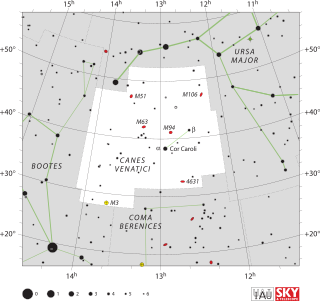
Canes Venatici is one of the 88 constellations designated by the International Astronomical Union (IAU). It is a small northern constellation that was created by Johannes Hevelius in the 17th century. Its name is Latin for 'hunting dogs', and the constellation is often depicted in illustrations as representing the dogs of Boötes the Herdsman, a neighboring constellation.
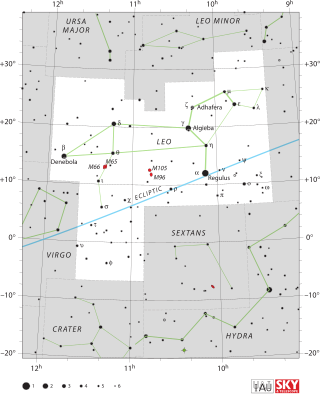
Leo is one of the constellations of the zodiac, between Cancer the crab to the west and Virgo the maiden to the east. It is located in the Northern celestial hemisphere. Its name is Latin for lion, and to the ancient Greeks represented the Nemean Lion killed by the mythical Greek hero Heracles meaning 'Glory of Hera' as one of his twelve labors. Its old astronomical symbol is (♌︎). One of the 48 constellations described by the 2nd-century astronomer Ptolemy, Leo remains one of the 88 modern constellations today, and one of the most easily recognizable due to its many bright stars and a distinctive shape that is reminiscent of the crouching lion it depicts. The lion's mane and shoulders also form an asterism known as "The Sickle," which to modern observers may resemble a backwards "question mark."

Libra is a constellation of the zodiac and is located in the Southern celestial hemisphere. Its name is Latin for weighing scales. Its old astronomical symbol is (♎︎). It is fairly faint, with no first magnitude stars, and lies between Virgo to the west and Scorpius to the east. Beta Librae, also known as Zubeneschamali, is the brightest star in the constellation. Three star systems are known to have planets.

Ursa Major is a constellation in the northern sky, whose associated mythology likely dates back into prehistory. Its Latin name means "greater bear", referring to and contrasting it with nearby Ursa Minor, the lesser bear. In antiquity, it was one of the original 48 constellations listed by Ptolemy in the 2nd century AD, drawing on earlier works by Greek, Egyptian, Babylonian, and Assyrian astronomers. Today it is the third largest of the 88 modern constellations.

Virgo is one of the constellations of the zodiac. Its name is Latin for maiden, and its old astronomical symbol is . Lying between Leo to the west and Libra to the east, it is the second-largest constellation in the sky and the largest constellation in the zodiac. The ecliptic intersects the celestial equator within this constellation and Pisces. Underlying these technical two definitions, the sun passes directly overhead of the equator, within this constellation, at the September equinox. Virgo can be easily found through its brightest star, Spica.
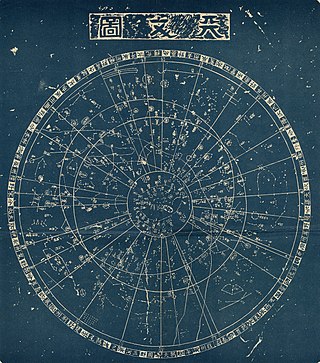
Traditional Chinese astronomy has a system of dividing the celestial sphere into asterisms or constellations, known as "officials".
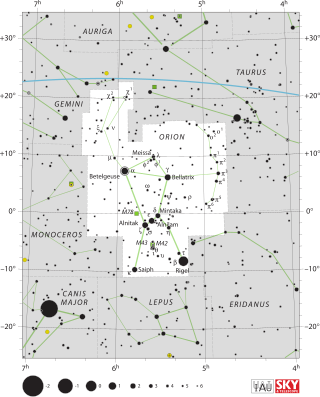
Orion is a prominent constellation located on the celestial equator and visible throughout the world. It is one of the most conspicuous and recognizable constellations in the night sky. It is named after Orion, a hunter in Greek mythology. Its brightest stars are the blue-white Rigel and the red Betelgeuse.

Coma Berenices is an ancient asterism in the northern sky, which has been defined as one of the 88 modern constellations. It is in the direction of the fourth galactic quadrant, between Leo and Boötes, and it is visible in both hemispheres. Its name means "Berenice's Hair" in Latin and refers to Queen Berenice II of Egypt, who sacrificed her long hair as a votive offering. It was introduced to Western astronomy during the third century BC by Conon of Samos and was further corroborated as a constellation by Gerardus Mercator and Tycho Brahe. It is the only modern constellation named for a historic person.

The Summer Triangle is an astronomical asterism in the northern celestial hemisphere. The defining vertices of this imaginary triangle are at Altair, Deneb, and Vega, each of which is the brightest star of its constellation. The greatest declination is +45° and lowest is +9° meaning the three can be seen from all places in the Northern Hemisphere and from the home of most people resident in the Southern Hemisphere. The two stars in Aquila and Cygnus represent the head of an eagle and tail of a swan that looks east inscribed into the triangle and forming the altitude of the triangle. Two small constellations, Sagitta and Vulpecula, lie between Aquila in the south of the triangle and Cygnus and Lyra to the north.

The Winter Triangle is an astronomical asterism formed from three of the brightest stars in the winter sky. It is an imaginary equilateral triangle drawn on the celestial sphere, with its defining vertices at Sirius, Betelgeuse, and Procyon, the primary stars in the three constellations of Canis Major, Orion, and Canis Minor, respectively.

An asterism is an observed pattern or group of stars in the sky. Asterisms can be any identified pattern or group of stars, and therefore are a more general concept than the 88 formally defined constellations. Constellations are based on asterisms, but unlike asterisms, constellations outline and today completely divide the sky and all its celestial objects into regions around their central asterisms. For example, the asterism known as the Big Dipper comprises the seven brightest stars in the constellation Ursa Major. Another is the asterism of the Southern Cross, within the constellation of Crux.

The Spring Triangle is an astronomical asterism involving an imaginary triangle drawn upon the celestial sphere, with its defining vertices at Arcturus, Spica, and Regulus. This triangle connects the constellations of Boötes, Virgo, and Leo. It is visible in the evening rising in the southeastern sky of the Northern Hemisphere between March and May and setting until August, while at morning rising and setting from November to the end of February.

The Big Dipper or the Plough is a large asterism consisting of seven bright stars of the constellation Ursa Major; six of them are of second magnitude and one, Megrez (δ), of third magnitude. Four define a "bowl" or "body" and three define a "handle" or "head". It is recognized as a distinct grouping in many cultures. The North Star (Polaris), the current northern pole star and the tip of the handle of the Little Dipper, can be located by extending an imaginary line through the front two stars of the asterism, Merak (β) and Dubhe (α). This makes it useful in celestial navigation.
Chinese star names are named according to ancient Chinese astronomy and astrology. The sky is divided into star mansions and asterisms. The system of 283 asterisms under the Three Enclosures and Twenty-Eight Mansions was established by Chen Zhuo of the Three Kingdoms period, who synthesized ancient constellations and the asterisms created by early astronomers Shi Shen, Gan De and Wuxian. Since the Han and Jin dynasties, stars have been given reference numbers within their asterisms in a system similar to the Bayer or Flamsteed designations, so that individual stars can be identified. For example, Deneb is referred to as 天津四.

NGC 5792 is a barred spiral galaxy about 70 million light-years away in the constellation Libra. There is a magnitude 9.6 star on the northwestern edge of the galaxy. It was discovered on April 11, 1787 by the astronomer William Herschel. It is a member of the Virgo III Groups, a series of galaxies and galaxy clusters strung out to the east of the Virgo Supercluster of galaxies.

The Northern Cross is an astronomical asterism in the northern hemisphere of the celestial sphere, corresponding closely with the constellation Cygnus the swan. It is much larger than the Southern Cross and consists of the brightest stars in Cygnus: Deneb, Sadr, Gienah, Delta Cygni and Albireo. The 'head' of the cross, Deneb, is also part of the Summer Triangle asterism.
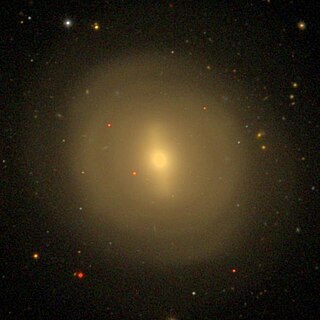
NGC 4477 is a barred lenticular galaxy located about 55 million light-years away in the constellation of Coma Berenices. NGC 4477 is classified as a type 2 Seyfert galaxy. The galaxy was discovered by astronomer William Herschel on April 8, 1784. NGC 4477 is a member of Markarian's Chain which forms part of the larger Virgo Cluster.



















